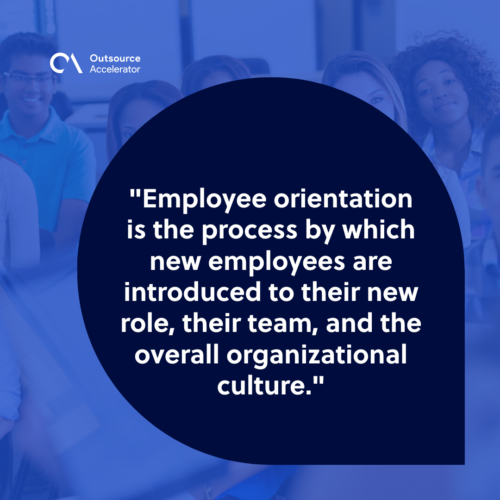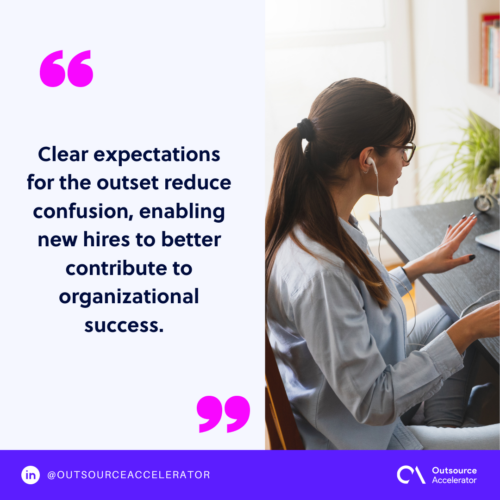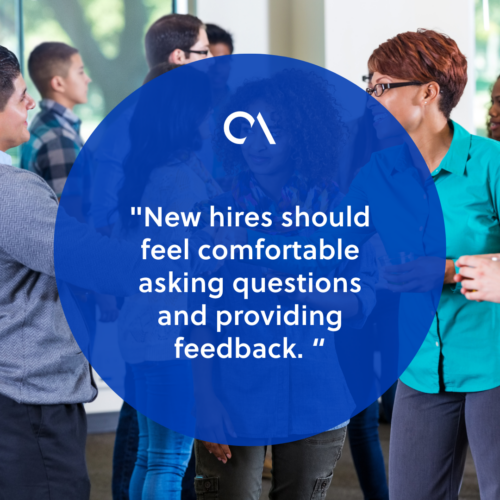Employee orientation: Definition, importance, and best practices

Employee orientation sets the foundation for a successful and harmonious work environment.
This orientation is the initial handshake, the first impression that sets the tone for a new hire’s journey within an organization. Far more than a bureaucratic formality, it also offers the necessary knowledge, resources, and support to help new employees perform well.
In this article, we’ll explore the importance of an effective employee orientation and how you can implement it for success and satisfaction in the workplace.
What is employee orientation?
Employee orientation is the process by which new employees are introduced to their new role, their team, and the overall organizational culture. It’s a structured program that aims to familiarize them with their new environment.
A new hire will be introduced to the company’s:
- Mission
- Values
- Policies
- Procedures
- Expectations
An effective employee orientation helps the new hires acclimate quickly and effectively integrate into the company. It typically includes activities such as orientation sessions, job training, and introductions to key staff members.
Additionally, it also discusses practical aspects such as completing paperwork and setting up equipment.

Employee orientation vs. Onboarding
Many organizations tend to use the terms “employee orientation” and “onboarding” to describe the same process. Officially, they represent two distinct phases of employee integration.
Here are the key differences between them:
| Employee orientation | Onboarding | |
| Timeframe | A short-term process that occurs during the initial days of an employee’s tenure | A longer-term process that can extend even through the first years of employment |
| Focus and objective | Focuses on providing basic company information | Focuses on the administrative, social, and cultural aspects of assimilating into the company |
| Content | Primarily covers administrative tasks | Includes more in-depth training and development activities |
| Integration and retention | Familiarizes new hires with their immediate work environment but may not guarantee long-term integration and retention | Emphasizes the successful integration, engagement, and long-term retention of new employees |
In summary, employee orientation represents the initial stage of introducing new hires to the organization. Onboarding covers a more comprehensive and extended process that focuses on settling employees into their roles and the company culture over time.
Why is employee orientation important?
Employee orientation is important for several reasons:
First impressions
Employee orientation sets the tone for the person’s experience with the company. A well-executed orientation creates a positive first impression, helping new hires feel welcomed and supported.
These people are likely to be feeling the stress and anxiety that comes with entering a new environment. It helps them transition out of this by providing them with the necessary guidance and support from the start.
Introduction to the organization
Employers should utilize employee orientation to provide new hires with all the essential information about the company’s policies, procedures, and values. This knowledge will help the latter navigate their work environment and minimize the risk of errors or compliance issues.
Use this time as well to communicate your expectations regarding their roles and responsibilities. Clear expectations for the outset reduce confusion, enabling new hires to better contribute to organizational success.

Building relationships
Employee orientation programs often include introductions to key staff members. This helps facilitate networking and relationship-building within the organization.
Strong interpersonal connections provide a support system where employees can feel comfortable to collaborate and seek support.
Productivity and performance
A well-planned orientation accelerates the integration process, allowing new employees to become productive more quickly. By equipping them with the necessary knowledge, skills, and resources, orientation maximizes their potential and enhances overall performance.
By investing time and care into a comprehensive employee orientation program, companies can improve the onboarding experience and increase retention and success.
9 employee orientation best practices
Here are some best practices to ensure an effective and engaging employee orientation experience:
1. Prepare in advance
Develop a clear and well-structured employee orientation program that outlines the key topics and activities to be covered. This plan should be tailored to the specific needs of your business and the role of the new employee.
Collect all necessary materials and resources ahead of time to ensure a smooth and organized orientation.
2. Provide a warm welcome
Throughout the orientation, create a welcoming and inclusive environment for the new employees. Aside from introducing them to team members, mentors, and staff, encourage existing employees to reach out and make them feel included.
3. Provide clear information
Ensure that new hires receive clear and concise information about important company policies, procedures, and resources.
Use a variety of formats, like presentations, handouts, and interactive discussions, to convey information efficiently.
4. Provide job-specific training
Provide training and development opportunities to help new hires acquire the knowledge and skills needed to excel in their roles. Tailor the program to include role-specific training.
This may involve job shadowing, on-the-job training, or specific training sessions conducted by subject matter experts.
5. Establish clear expectations
Clearly communicate performance expectations, goals, and objectives. Provide clarity on job responsibilities, performance metrics, and any specific targets that need to be met.
This can help new employees understand what is expected of them and foster a sense of accountability.
6. Personalize the experience
Customize the orientation experience to reflect the individual needs and interests of each new hire. Consider their background, skills, and goals, and incorporate opportunities for them to learn and grow within their role.
7. Encourage questions and feedback
Create a safe and open environment that encourages participation and engagement. New hires should feel comfortable asking questions and providing feedback.

8. Follow-up and support
Follow up with new hires after orientation to ensure they have the assistance and resources they need to succeed. Actual integration extends beyond the initial welcome period.
Provide opportunities for ongoing feedback, coaching, and mentorship to help new employees settle into their roles and overcome challenges. This can help them feel supported and engaged in their new situation.
9. Evaluate and improve
Continuously evaluate the effectiveness of your orientation program. Seek feedback from new hires and other stakeholders to identify areas for improvement.
Adjust and refine the program over time, making sure it always aligns with the needs of new employees.
By implementing these best practices, organizations can create an impactful employee orientation experience that showcases their culture and sets up new hires for success.







 Independent
Independent




